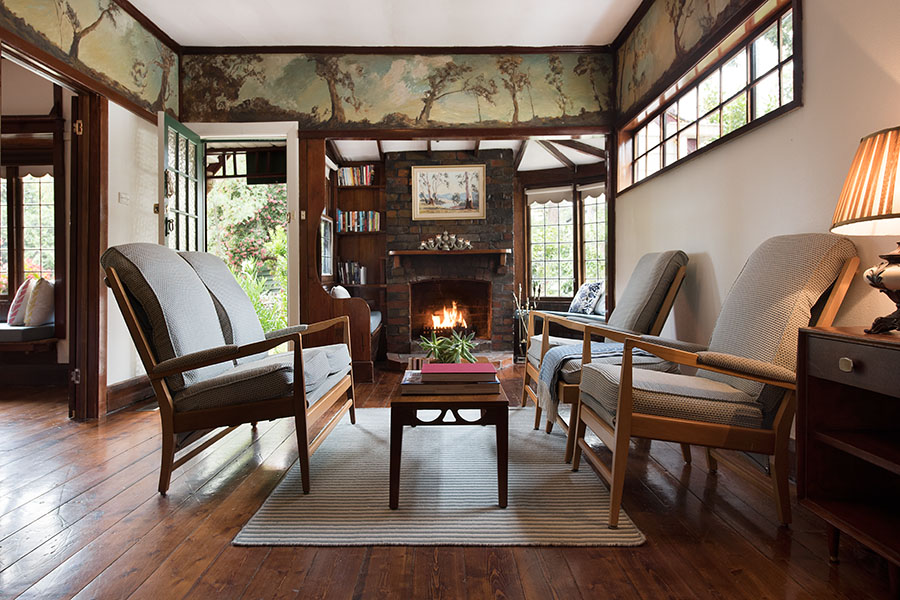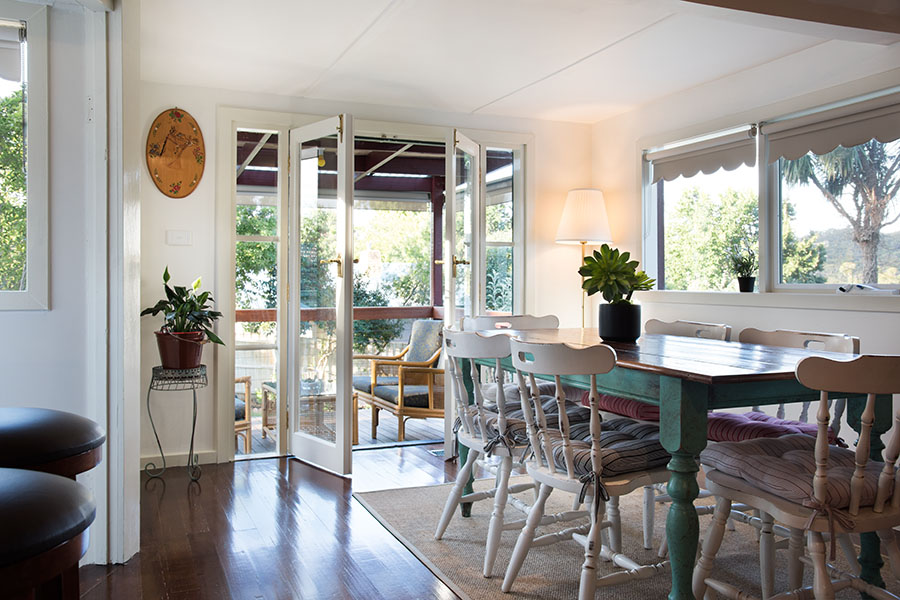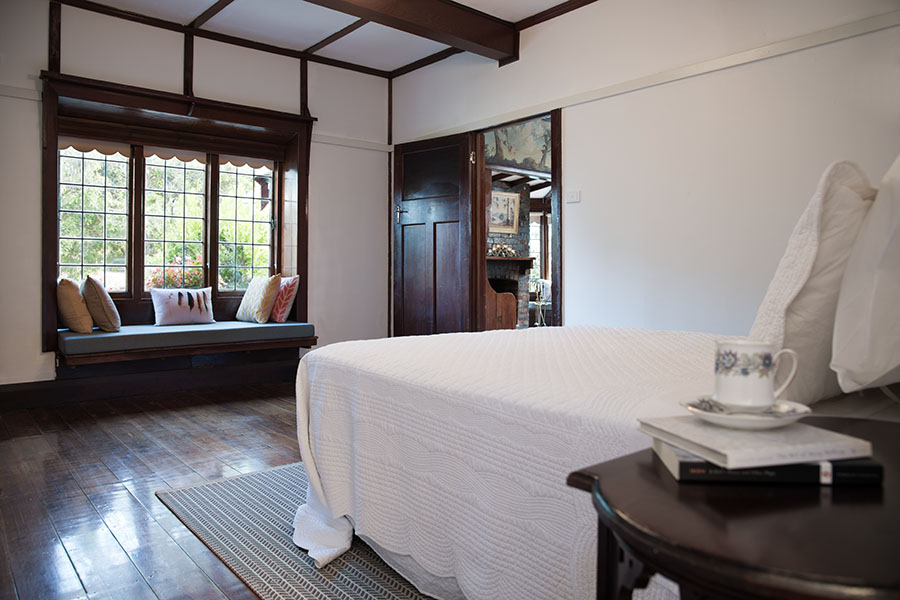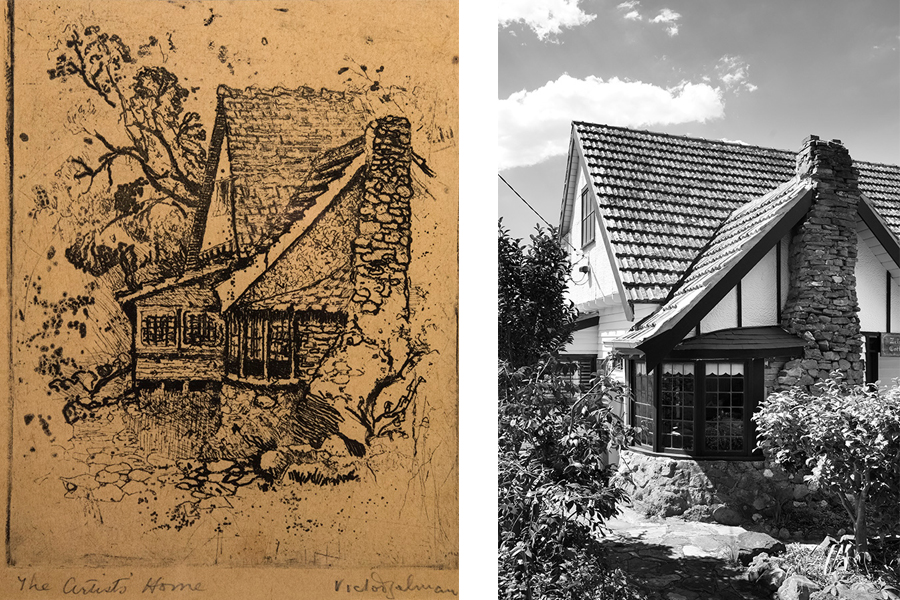Built circa 1910 by accomplished musician and prominent landscape artist Victor Zelman, this lovely three bedroom cottage is now once again a holiday home. This is a rare opportunity to immerse yourself in a place of great historical and artistic significance.

When owners Joseph and Lana purchased 4 Seventh Street Hepburn Springs, they knew that they were not just purchasing a classic cottage in a beautiful location, but a property of great historical and artistic significance. As the new custodians of the home built by accomplished musician and prominent landscape artist Victor Zelman and his wife Clara, they felt a great responsibility to maintain the charm and feel of the cottage as it would have felt in the Zelman era. They passionately went about restoring the magnificent frieze painted by Victor that runs around the living room walls, so that others can share in and enjoy a little slice of Hepburn Springs history.
We are thrilled to have Zelman Cottage on the portfolio. This is a rare opportunity to immerse yourself in a place of historical significance and stay in a cottage where so much art, music, love and big conversations would have taken place under the ownership of Victor Alexander Zelman.
Below we are delighted to include for you an extract from an academic paper written by Dr Margaret Dillon in 2016 on Victor Zelman’s life and that of his famous and very influential family throughout Art and Music in Australia.

Victor Alexander Zelman, Australian Artist, 1877–1958.
The following is extracted from Australian Colonial History
Author: Dr Margaret (Meg) Dillon
Early Zelman family history
Alberto Zelman (senior), a trained musician from Trieste, Austria, arrived in Sydney in 1871 and toured Australia and New Zealand with the Cagli-Pompei Opera Company. He returned to Melbourne in 1872 when the company came under the control of W.S. Lyster, a well-known local music entrepreneur. Alberto (senior) started conducting operas in Melbourne in May 1872. Shortly after this in 1873, he married Harriet Elizabeth (Emily) Hodgkinson, a 22-year-old musician at the Fitzroy Registry Office. They had four sons Alberto (junior), Ernest, Victor and Alfred. Alberto (senior) became a much loved figure in Melbourne’s growing musical scene that entertained the middle class with both classical and light music. All his sons gained some training in musical instruments, with Alberto (junior) becoming an outstanding musician and teacher. He continued his father’s legacy and took over his mantel of one of the premier musical authorities in Melbourne. He founded the Melbourne Symphony Orchestra in 1907 and continued his stellar career until his premature death in 1927. Both father and son encouraged and promoted the careers of many female musicians at a time when this was quite unusual.
Melbourne loved the air of the culturally exotic that was attached to the talented Zelman family, at a time when society was both staid and Anglo-centric. This fascination was enhanced by the mystery of their origins in Europe. While some stories suggest Alberto Zelman [senior] was the son of Samual Victor Zelman (1805 – 1859) a linguist who was musically educated in Triesteiv, Alberto (junior) provided a far more romantic version of their family origins to Tabletalk magazine. He claimed his father was the son of a poet from Florence, Italy, who had become involved in one of the many radical political movements that swept Europe in the early 1800s. He fled to Trieste, which at that time was under the rule of the Austrian Habsburg Empire,vi and changed his family name to “Samual Victor Zelman” to conceal his identity from Florentine spies. He lived there safely after this and never revealed to his son his original Italian name, except to say his Christian name had been Vittorio.

Victor Zelman, early life.
Very little personal information exists in the public domain about Victor Zelman. There appears to be no collections of letters, sketchbooks, notebooks or other personal memorabilia in any major library or archives. Only one photograph exists of him as an adult. Because of this the following comments can only offer a brief overview of some aspects of his life but can provide no particular insights into his personal life or ideas.
Victor lived in Carlton with his parents as a child and attended the Kings College Fitzroy, probably as a weekly boarder until the family moved to Hawthorn after which the brothers attended local government schools. All the brothers were taught musical instruments by their father and various tutors. Victor mastered the viola and violin and performed in chamber orchestras as a young man.
Hepburn Springs became important to Ernest and Victor’s lives when they married into the Borsa family who had property throughout the district including a brewery in Daylesford that was owned by Battisto Borsa the family patriarch. Ernest married Blanche Borsa in 1903 and Victor married her sister Clara in 1907. Gertrude Borsa, another sister, managed the guest house, Bellinzona, in Hepburn Springs that was burnt down in 1906 during the disastrous fires that destroyed almost all of that village. The Borsas rebuilt it as an elegant holiday retreat for middle class Melbournians and opened it again in 1907 . It is thought that Victor established his studio and house in Hepburn Springs around 1910, while maintaining his Melbourne residence in the suburb of Canterbury. The small holiday cottage still stands and was an important continuing connection for Victor and his wife with the Italian residents of the district, some of whom were guests at their Canterbury home.

Training and Influences as an Artist
Victor trained at the National Gallery School in Melbourne, where he would have been introduced to both soft ground etching and the plein air style of small paintings that became his trademark and sold well.
He was a student at the National Gallery School in 1895 when he was 18 years old although it’s not certain whether he was a day or evening student, nor is it known when he started or finished the course. A traditional style of painting continued to be taught at the National Gallery Art School in Melbourne until the 1940s, firmly entrenched there by the views of Gallery directors who believed that craftsmanship and beauty were two of the key attributes that the Gallery School should teach. Victor’s landscapes suggest that his painting in the 1920s and 1930s was strongly influenced by the paintings of Frederick McCubbin, an Australian Impressionist painter and Drawing Master at the National Gallery School from 1886 to 1917.
It is possible that Victor received some training in the processes of printing and etching from the Melbourne printmaker John Mather, a Scot, who studied at the Institute of Fine Arts Glasgow and at the Edinburgh National Gallery School before arriving in Melbourne in 1878. Mather also taught at the Melbourne National Gallery School and gave private lessons. He may also have had some contact with John Shirlow who attended the National Gallery Art School as an evening student between 1890 -1895 and produced the first Australian portfolio of etchings of local scenes in 1904.
After finishing his training, Victor exhibited frequently with other groups of artists in the general exhibitions organised by the various artists’ societies in Melbourne including The Victorian Artists’ Society, The Melbourne Artists’ Society, The Fine Art Society, The Painters and Etchers’ Society, The New Gallery and submitted work in various municipal art competitions and exhibitions. His work was also exhibited in Sydney Australia in 1923 and in the British Empire Exhibition of 1924 – 1925 in Wembley, England. He appears to have been a tireless worker and earned his living from his art practice and to a lesser extent various musical recitals in small chamber orchestras playing the viola and violin. His income from artworks was substantial. His exhibition of April 1925 at the Fine Arts Society’s Gallery would have grossed just over £435 and with two or more such solo exhibitions a year and entries into group exhibitions, he could support a very comfortable life style.
Although Victor remained true to landscape painting, he did have some contact with some of the local change makers in art, not only through the diverse range of artists who exhibited at the same galleries as he did, but also with George Bell, one of the first who started the movement towards European Modernism in Victoria. Bell took violin lessons from both Victor and his brother Alberto. Victor’s new directions into landscape painting in the early 1920s may have been influenced by Bell’s return to Victoria in 1920 after studying contemporary art in London where post impressionism and cubism came to his notice. Bell opened his School of Creative Art in 1932 as a direct response to several important exhibitions of Modernism in Melbourne in that year: the Herald’s ground breaking travelling exhibition of works imported from Europe and America sponsored by Keith Murdoch; and the first exhibition of the newly formed Contemporary Group. While there is no evidence that Victor later attended any classes at Bell’s school, he could not have been immune to these exhibitions and the sensation they caused in Melbourne.
Bell was later instrumental in the formation of the Contemporary Art Society (Melbourne). He organized a meeting of 170 local artists at the Victorian Artists Society’s rooms in July 1938, where a constitution was adopted and the C.A.S. officially founded. This challenge to the teaching of the National Gallery School had been building throughout the 1930s and had been fostered by discussions and meetings between artists at the many casual meeting places around Melbourne’s Arts precinct in Little Collins, Collins, Bourke and Swanston Streets. Café Petrushka, Risties Coffee House, the Mitre Tavern and the Swanston Family Hotel were all popular venues for artists to meet, as well as in the many cheap studios that artists rented in this area. Most particularly, the Leonardo Art Shop in Little Collins Street, opened by an Italian Gino Nibbi in 1930, provided the first books of modern art reproductions for local artists to study and was a key meeting place. Victor’s connections to the Italian community are likely to have led him there.
The increasing influence of contemporary art in the 1930s and the bitter accusations and arguments between supporters of both styles of painting, along with the start of World War Two may have influenced Victor to leave Melbourne and permanently shift to Hepburn Springs in the early 1940s.

His Career in Art
Victor was 46 when he held his first solo exhibition of paintings in Melbourne In August 1923 at a small gallery run by Margaret McLean in the Tunnocks building at 125 Collins Street. It was reviewed in both the Age and Argus newspapers. The unnamed Age reviewer described it as a “loveable little show amidst picturesque surroundings” and implied that Victor was known already and setting out in a new direction with his landscape paintings. Victor was firmly in the camp of the landscape artists who dominated the Melbourne art scene until the end of the 1930s. Plein aire and impressionist landscapes were the popular choice of the Melbourne art public at this time. It was at the very end of the era started by the Australian Impressionist painters in the 1880s and soon to be riven by the huge challenges to its dominance by the Modernists.
The Age review encouraged him and the public by adding “Mr Zelman has paid us a charming complement -he exhibits only his best work … all carefully studied and entirely satisfactory panels.” His reviewer hoped that “If promises are fulfilled he will carve himself a niche among Australian landscape painters.” The review concluded, “We will watch with deep interest Mr. Zelman’s future work.”.
Victor continued to get encouraging reviews from the Argus and Age newspapers throughout the 1920s. The society gossip magazine Tabletop also reviewed his work favorably. His natural clientele was the comfortable middle class of Melbourne including so-called titled individuals who sometimes opened his exhibitions with condescending approval, but provided that cache of exclusiveness that was important in attracting sales. At one such opening, Lady Creswell claimed his name was “a household word in Victoria” and had painted in the hills on their property where she sent out a “jug of tea and cakes” to him to refresh him in his labors.
Victor can be described as a regional painter who travelled extensively throughout central Victoria and Melbourne’s rural fringes to paint images of small rural farms and the remnant bushland. In doing so he has left us a record of these vanished places from the early twentieth century. Throughout the 1920s and 1930s, his travels produced many small plein aire paintings approximately 30 x 20 cm and studies for larger works up to 70 x 90 cm. He would stay for some time in an area working at a number of canvasses before returning to his studio. Amongst the places named in his paintings are Romsey, Carlsruhe, Croydon, Castlemaine, Glen Waverley, Dromana, Rosebud, Shoreham, Mooroolbark, Diamond Creek, Ashburton, Lilydale, Port of Melbourne and the Goulburn and Murray Rivers. When at home he painted and etched many scenes from his local area – Hepburn Springs and Daylesford.

The paper was extracted from Australian Colonial History: http://australiancolonialhistory.com/index_htm_files/Final%20Draft%20Vict%20Zelman.pdf
Dr Margaret (Meg) Dillon profile: australiancolonialhistory.com
In the full article, you will find all citations and details of the below information.
- A list of paintings and etchings located in public galleries
- Paintings singled out for particular approval at exhibitions
- Titles of paintings and etchings that have passed through auction houses recently
- Watercolours
- Prints or Etchings

